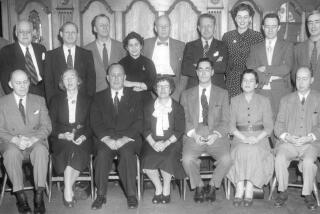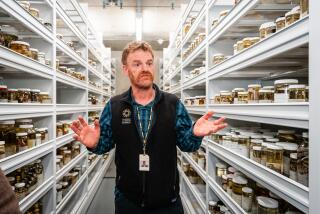Poisonous Drugs Were Used on Victims : Studentâs Probe of Voodoo Uncovers Secret of Zombies
CAMBRIDGE, Mass. â Wade Davis, a Harvard University botany student, was asked by his adviser three years ago to fly to Haiti and investigate whether there was any truth to the voodoo myth of zombies.
After a series of expeditions over 2 1/2 years, he returned to Cambridge with malaria, hepatitis, the material for a nonfiction book said to read like a spy novel--and the secret formula for creating zombies.
âI left knowing nothing about the country and arrived with only my wits,â said Davis. âI was lucky, extremely lucky. I opened a Pandoraâs box that consumed three years of my life.â
The blond, blue-eyed Canadian is currently in seclusion on a Virginia farm recovering from his illnesses, working on the book to be published in the fall by Simon and Schuster, called âThe Serpent and the Rainbow,â and finishing his Ph.D. thesis.
Sophisticated Practice
The first thing he discovered was that voodoo and zombies were very different from they way they have been portrayed in the movies. Voodoo is a sophisticated religion with African roots. It is practiced by the vast majority of Haitians as well as people on other Caribbean islands and in Brazil.
âIt has a system of medicine, a system of education and a system of law and order. It appears that this zombie thing may be linked to the whole system of social sanctions,â said Davis, whose Virginia log cabin is filled with books, voodoo masks, Indian headbands and skulls.
Zombies are not people who have risen from the dead. Instead, they are people who have been given a drug that mimics death, paralyzing them and reducing their heart and breathing rates to almost nothing. Yet, they remain conscious.
Link With Drugs
Davis, 31, was sent to Haiti by the Harvard Botanical Museum, the worldâs foremost institution for the study of psychoactive drugs, most of which are made from plants. As a graduate student at the museum, he was an expert on plant-derived pharmaceuticals.
If there was any basis to the myth, experts reasoned, it probably had something to do with a drug made from plants.
In addition, Davis had worked in the past with natives of the Amazon jungle and the Indians of northern Canada while working as a lumberjack.
As it turned out, the active ingredient in the secret formula for creation of zombies was a poison, called tetrodotoxin, which is taken from puffer fish and is 500 times more powerful than cyanide.
âItâs the most powerful non-protein poison in the world,â Davis said. âA drop that can rest on the head of a pin is enough to kill.â
He keeps a 2-inch vial of the formula with him. It looks like dry black dirt. The formula also contains parts of toads, sea worms, lizards, tarantulas and human bones. âItâs basically a potpourri of weird things,â said Davis.
The formula is thought to be ground into the skin of intended victims. They begin to feel nauseous and have difficulty breathing. Then they begin to get a pins-and-needles feeling in their limbs, which progresses to their whole body. They become paralyzed and their blood pressure drops very low. Their lips turn blue for lack of oxygen. The process takes about six hours.
First Documented Case
The first medically documented case of a zombie was a victim named Clervius Narcisse, who was pronounced dead in 1962 by an American doctor living in Haiti. Narcisse was buried, but, in 1982, he returned to his hometown alive.
His fingerprints were checked by Scotland Yard and matched those of the dead man, Davis said. Narcisse told Haitian psychiatrist Dr. Lamarque Douyon facts about his family that only the dead man could have known.
The victim said he remembers being pronounced dead, remembers hearing his sister crying at his funeral and remembers being buried.
That night, a voodoo priest dug him up from his grave and put him on a plantation. He said he escaped, but did not return to his hometown for 20 years because he feared his brother, who he said had him made into a zombie in the first place.
Traditionally, after being dug up, the victim would be given another formula, which was thought to be an antidote. But Davis realized that if the victim survived the initial crisis, no antidote would be needed. Instead, the second drug may have been one that induces amnesia and psychosis, making the victim dependent on the people who drugged him.
Fate Worse Than Death
For Haitians, who place high value on their independence and free will, becoming a zombie can be a fate worse than death.
Davis said people are not made into zombies for just any reason. Usually, they are accused of breaking strict voodoo codes. Secret societies, similar to groups in Western Africa, hold tribunals to determine a personâs guilt or innocence. If found guilty, the court orders that the formula be rubbed on their bodies.
âThe biggest challenge was separating spiritual beliefs from pharmacological realities,â said Davis.
Once the case of Clervius Narcisse was documented, researchers contacted Richard Evans Schultes, director of botanical museum.
Schultes in turn assigned Davis to the case.
âHe asked me if I was doing anything important during the next month or so. And I said no. So he told me to get on the next plane to Haiti,â said Davis. âMy assignment was to go down there and get hold of the drug and see if, in fact, it had anything interesting in it. In a series of expeditions, that is what I did,â said Davis.
Davis published his findings in the Journal of Ethnopharmacology, a Swiss science journal concerned with the study of ancient drugs.
When news of the report appeared recently in Haitian newspapers, voodoo priests scoffed. They said they did not believe outsiders could have gotten hold of the well-guarded secret.
âThey have a long way to go,â one voodoo priest said.
Davis says he posed as a representative of the Mafia in order to obtain the formula.
Well-Known Poison
Tetrodotoxin is a well-known poison, being found in the puffer fish commonly eaten by the Chinese and Japanese. In Japan, special chefs are licensed to prepare the fish. They remove enough poison to make it non-lethal, yet enough remains to make diners high.
âThey feel euphoria and tingling up and down their spines and in their limbs,â said Davis. âBut, because of it, still 100 people die each year.â
Davis hopes his book and the publicity from his discovery will do more than simply generate an interest in voodoo.
âIt will force people to look at themselves carefully before judging something they donât understand,â he said. âIâm interested in promoting the wonder of cultural and biological diversity. This is a wonderful way of doing it. It shows that many things make sense within a particular culture.â
More to Read
Sign up for our Book Club newsletter
Get the latest news, events and more from the Los Angeles Times Book Club, and help us get L.A. reading and talking.
You may occasionally receive promotional content from the Los Angeles Times.








